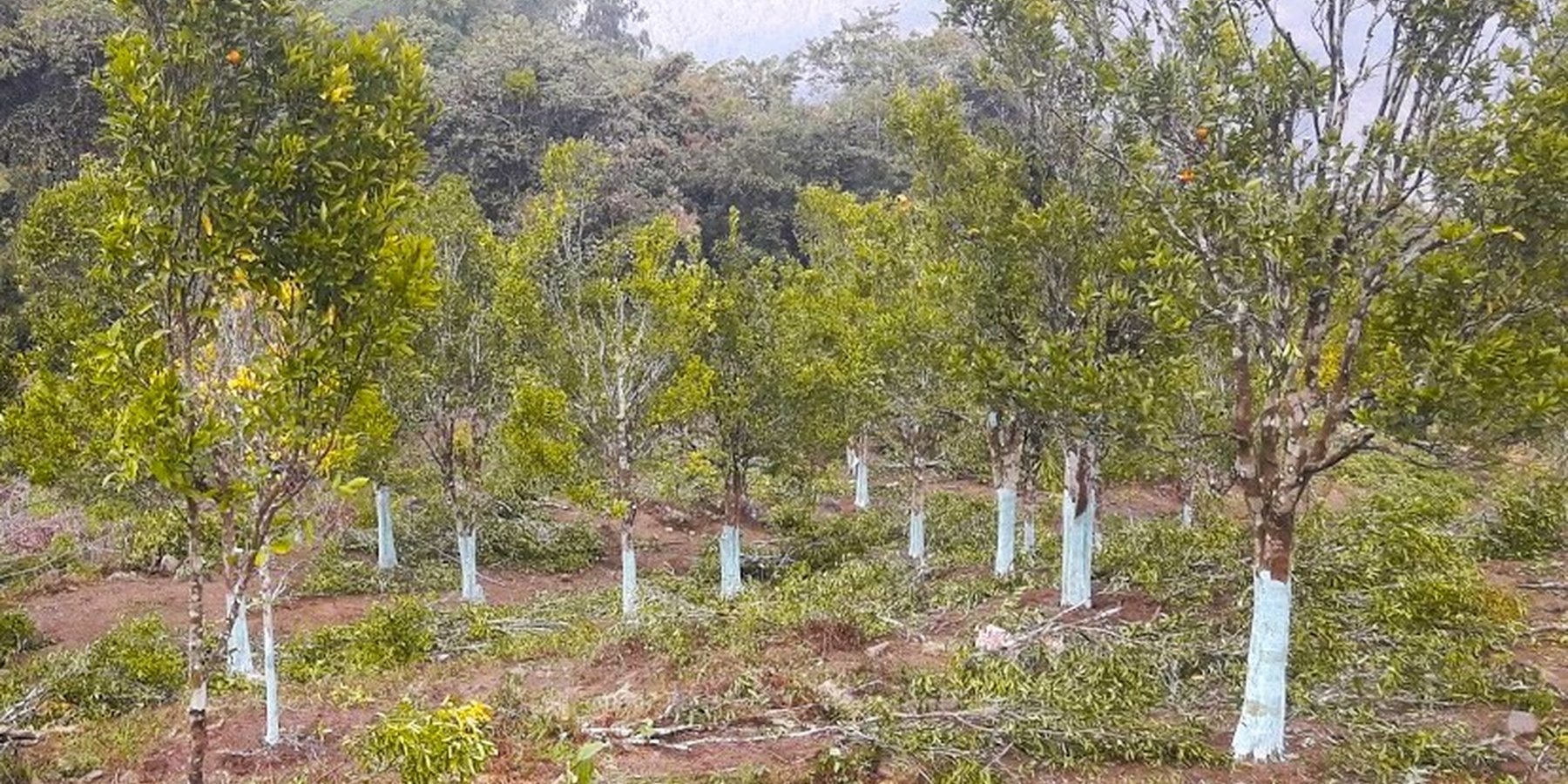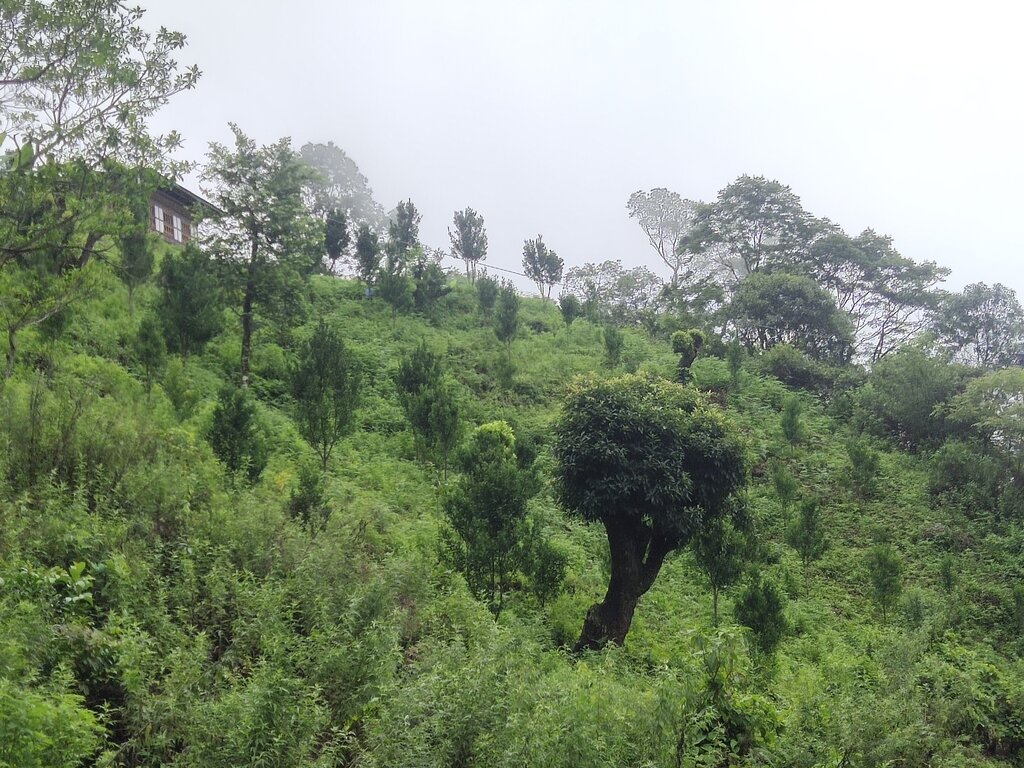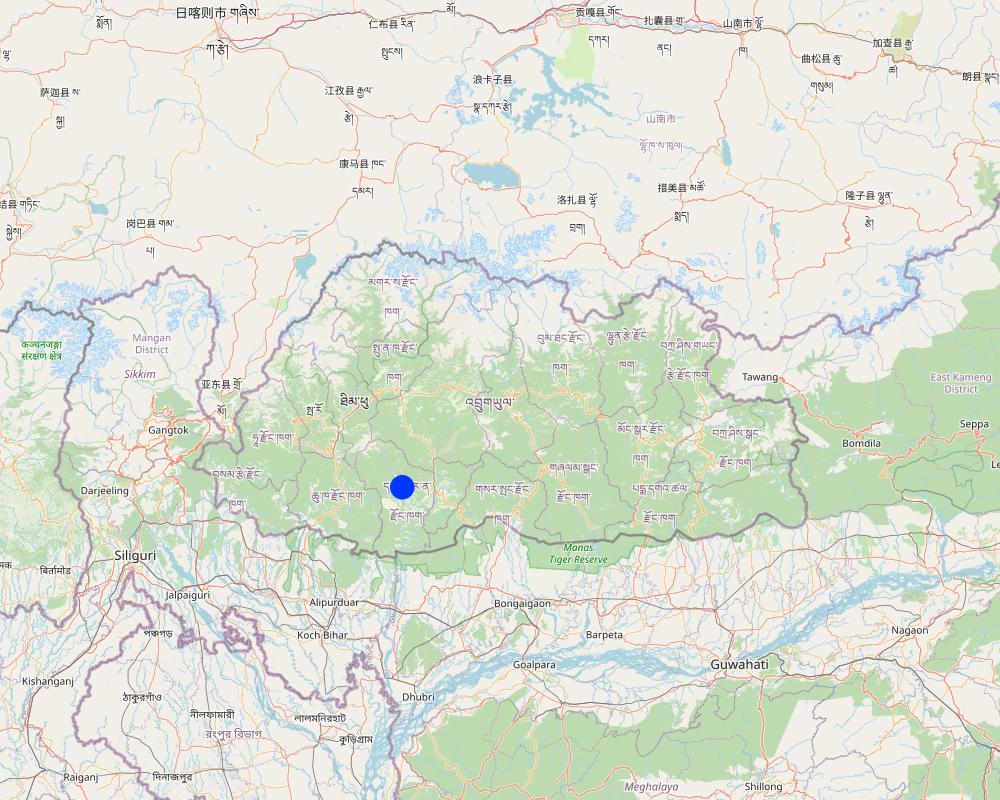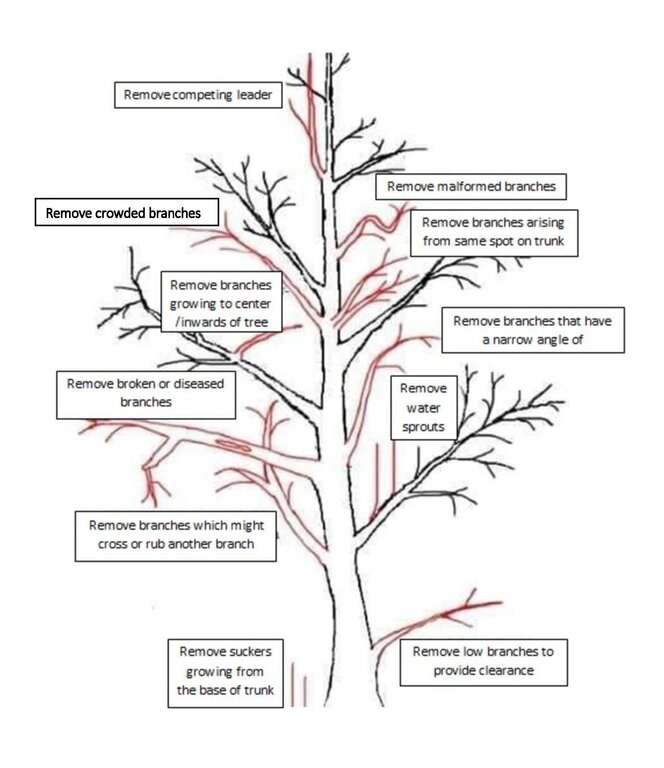Citrus Canopy Management and Rehabilitation Program [Bhoutan]
- Création :
- Mise à jour :
- Compilateur : Nima Dolma Tamang
- Rédacteur : Kuenzang Nima
- Examinateurs : William Critchley, Rima Mekdaschi Studer, Joana Eichenberger
Tshel Shing Zin Chong Dang Nyam Sung Ley Rim (ཚལ་ཤིང་འཛིན་སྐྱོང་དང་ཉམས་སྲུང་ལས་རིམ།)
technologies_6847 - Bhoutan
Voir les sections
Développer tout Réduire tout1. Informations générales
1.2 Coordonnées des personnes-ressources et des institutions impliquées dans l'évaluation et la documentation de la Technologie
Personne(s)-ressource(s) clé(s)
exploitant des terres:
Lethro
Bhoutan
Nom du projet qui a facilité la documentation/ l'évaluation de la Technologie (si pertinent)
Strengthening national-level institutional and professional capacities of country Parties towards enhanced UNCCD monitoring and reporting – GEF 7 EA Umbrella II (GEF 7 UNCCD Enabling Activities_Umbrella II)Nom du ou des institutions qui ont facilité la documentation/ l'évaluation de la Technologie (si pertinent)
National Soil Services Centre, Department of Agriculture, Ministry of Agriculture & Livestock (NSSC) - Bhoutan1.3 Conditions relatives à l'utilisation par WOCAT des données documentées
Le compilateur et la(les) personne(s) ressource(s) acceptent les conditions relatives à l'utilisation par WOCAT des données documentées:
Oui
1.4 Déclaration sur la durabilité de la Technologie décrite
Est-ce que la Technologie décrite ici pose problème par rapport à la dégradation des terres, de telle sorte qu'elle ne peut pas être déclarée comme étant une technologie de gestion durable des terres?
Non
2. Description de la Technologie de GDT
2.1 Courte description de la Technologie
Définition de la Technologie:
Citrus canopy management refers to the set of practices and techniques employed to optimize the growth, health, and productivity of citrus trees by manipulating the structure and density of their canopy. Effective canopy management is crucial for achieving desirable outcomes in citrus cultivation, such as improved fruit quality, increased yields, efficient use of resources, and enhanced tree health.
2.2 Description détaillée de la Technologie
Description:
Citrus canopy management practices remain basic in Bhutan. Thus, the Australian Centre for International Agricultural Research (ACIAR) project was initiated and demonstrated citrus canopy management practices in selected orchards in 2010. In the same year, the Japan International Cooperation Agency (JICA) project trained land users and extension officers in eastern Bhutan on citrus management practices such as planting methods, nutrient management, pruning and training including top working, fruit thinning and post-harvest management practices. Since then, citrus growers have been slowly adopting the practices in their orchards. However, the adoption rate is low - affecting the yield and quality.
Bhutan has suitable climatic conditions for citrus production, particularly in the southern parts of the country due to the subtropical climate. Citrus such as oranges, mandarins and lemons are grown in orchards and home gardens. In Bhutan, citrus canopy management practices focus on optimizing tree growth, fruit production, and overall tree health. The main elements include pruning, training systems, canopy density management, tree height and size control, and disease and pest management integrated with irrigation and nutrient management practices. Pruning involves selectively removing branches, shoots, or foliage to shape the tree and improve its health. The stump should always be cut as close to the collar region as possible. Training structures the tree in a specific manner to optimize growth and management. Canopy density management regulates foliage density for light penetration and airflow. Techniques such as hedging or topping control the height and size of trees. Disease and pest management practices include adequate air circulation and sunlight exposure. Integration with irrigation and soil nutrient management enhances tree health and productivity. The desirable shape and size of citrus are variable depending on the grower's choice, location, and - most importantly - operational health and safety concerns. In general, the desirable shape and size of the tree should be 2 to 5 m tall, 2 to 5 m width of canopy, and 4 to 6 primary (scaffold) branches that are at least 1 m above the ground level.
The purposes/functions of citrus canopy management technology are to optimize fruit production, improve tree health, and facilitate harvest and maintenance operations. It helps maximize fruit yield and quality. Pruning and maintenance practices enhance tree vigour, reduce the risk of diseases and pests, and improve overall plant health. Controlling tree size and shape makes harvesting easier and more efficient, and simplifies other maintenance activities such as irrigation, fertilization, and pest control.
To establish and maintain citrus canopy management technology, activities such as regular pruning and training, knowledge and skill development, use of proper tools and equipment, monitoring and assessment, irrigation, and nutrition management are required. Regular pruning and training of citrus trees according to the selected system and management objectives is essential. Monitoring tree growth, health, and productivity is important, along with proper irrigation scheduling, water management, and nutrient application.
The benefits/impacts of the technology are improved sunlight exposure, enhanced air circulation, reduced disease incidence, increased fruit size and quality, ease of harvest, consistent yield, optimized water use, better pest management, and others. A well-managed canopy makes it easier to access the fruit during harvest, and achieve higher yields and better-quality fruits, reduced need for pesticides, as well as directing nutrients toward fruit production rather than excessive vegetative growth. However, there are some drawbacks of the technology such as the requirement for time-consuming manual labour, lower initial yields, high initial investments for equipment, and concerns about over-pruning.
2.3 Photos de la Technologie
2.5 Pays/ région/ lieux où la Technologie a été appliquée et qui sont couverts par cette évaluation
Pays:
Bhoutan
Région/ Etat/ Province:
Dagana Dzongkhag
Autres spécifications du lieu:
Nindukha Village, Kana Gewog
Spécifiez la diffusion de la Technologie:
- répartie uniformément sur une zone
S'il n'existe pas d'informations exactes sur la superficie, indiquez les limites approximatives de la zone couverte:
- < 0,1 km2 (10 ha)
Est-ce que les sites dans lesquels la Technologie est appliquée sont situés dans des zones protégées en permanence?
Non
Map
×2.6 Date de mise en œuvre de la Technologie
Indiquez l'année de mise en œuvre:
2019
2.7 Introduction de la Technologie
Spécifiez comment la Technologie a été introduite: :
- par le biais de projets/ d'interventions extérieures
3. Classification de la Technologie de GDT
3.1 Principal(aux) objectif(s) de la Technologie
- améliorer la production
- s'adapter au changement et aux extrêmes climatiques et à leurs impacts
- créer un impact économique positif
3.2 Type(s) actuel(s) d'utilisation des terres, là où la Technologie est appliquée
Les divers types d'utilisation des terres au sein du même unité de terrain: :
Non

Terres cultivées
- Plantations d’arbres ou de buissons
Plantations d'arbres et d'arbustes - Précisez les cultures:
- citron
Nombre de période de croissance par an: :
- 1
Est-ce que les cultures intercalaires sont pratiquées?
Non
Est-ce que la rotation des cultures est appliquée?
Non
3.3 Est-ce que l’utilisation des terres a changé en raison de la mise en œuvre de la Technologie ?
Est-ce que l’utilisation des terres a changé en raison de la mise en œuvre de la Technologie ?
- Non (Passez à la question 3.4)
3.4 Approvisionnement en eau
Approvisionnement en eau des terres sur lesquelles est appliquée la Technologie:
- mixte: pluvial-irrigué
3.5 Groupe de GDT auquel appartient la Technologie
- gestion intégrée de la fertilité des sols
- gestion de l'irrigation (incl. l'approvisionnement en eau, le drainage)
- Tree canopy management
3.6 Mesures de GDT constituant la Technologie

pratiques végétales
- V5: Autres

autres mesures
Précisez:
Improve/optimize fruit production and quality by manipulating the growth and structure of trees.
3.7 Principaux types de dégradation des terres traités par la Technologie

dégradation biologique
- Bc: réduction de la couverture végétale
Commentaires:
Citrus canopy management increases productivity and reduces its susceptibility to diseases which ensures vegetation cover as the trees are not removed.
3.8 Prévention, réduction de la dégradation ou réhabilitation des terres dégradées
Spécifiez l'objectif de la Technologie au regard de la dégradation des terres:
- prévenir la dégradation des terres
- réduire la dégradation des terres
4. Spécifications techniques, activités, intrants et coûts de mise en œuvre
4.1 Dessin technique de la Technologie
Spécifications techniques (associées au dessin technique):
The spacing between trees is 6 m. There are a total of 100 trees per acre. Diseased or damaged trees are removed.
Auteur:
Thinley Penjor Dorji
Date:
22/08/2023
4.2 Informations générales sur le calcul des intrants et des coûts
Spécifiez la manière dont les coûts et les intrants ont été calculés:
- par superficie de la Technologie
Indiquez la taille et l'unité de surface:
2.47 acre
Si vous utilisez une unité de superficie locale, indiquez le facteur de conversion vers un hectare (p.ex. 1 ha = 2.47 acres): 1 ha = :
1
autre/ monnaie nationale (précisez):
Ngultrum (Nu.)
Indiquez le taux de change des USD en devise locale, le cas échéant (p.ex. 1 USD = 79.9 réal brésilien): 1 USD = :
80,0
Indiquez le coût salarial moyen de la main d'œuvre par jour:
500
4.3 Activités de mise en place/ d'établissement
| Activité | Calendrier des activités (saisonnier) | |
|---|---|---|
| 1. | Pruning | Right after harvest |
| 2. | Applying Bordeaux mixture | Anytime |
| 3. | Making basin | Winter |
| 4. | Applying manure | Anytime |
| 5. | Removal of dead woods or shoots | Anytime |
4.4 Coûts et intrants nécessaires à la mise en place
| Spécifiez les intrants | Unité | Quantité | Coûts par unité | Coût total par intrant | % des coût supporté par les exploitants des terres | |
|---|---|---|---|---|---|---|
| Main d'œuvre | Pruning | Person/day | 17,0 | 500,0 | 8500,0 | 100,0 |
| Equipements | Pruning saw | Number | 1,0 | 2000,0 | 2000,0 | 100,0 |
| Equipements | Secateurs | Number | 1,0 | 2500,0 | 2500,0 | 100,0 |
| Matériel végétal | Sapling | Number | 247,0 | 150,0 | 37050,0 | |
| Engrais et biocides | Bordeaux mixture | Litres | 12,0 | 125,0 | 1500,0 | |
| Coût total de mise en place de la Technologie | 51550,0 | |||||
| Coût total de mise en place de la Technologie en dollars américains (USD) | 644,38 | |||||
Si le coût n'est pas pris en charge à 100% par l'exploitant des terres, indiquez qui a financé le coût restant:
The cost for sapling and biocide is borne by the Royal Government of Bhutan.
Commentaires:
The total establishment cost of the technology for one hectare is USD 644.38. The Land users paid 100% of the equipment's cost. They follow a labour-sharing system whereby the labour employed in the farm is compensated by working in their fields and there is no cost involved.
4.5 Activités d'entretien/ récurrentes
| Activité | Calendrier/ fréquence | |
|---|---|---|
| 1. | Pruning of dead woods and water shoots | Anytime |
| 2. | Fertilizer application | Anytime |
| 3. | Shoot selection in the following years | Every year when new shoots sprout |
4.6 Coûts et intrants nécessaires aux activités d'entretien/ récurrentes (par an)
| Spécifiez les intrants | Unité | Quantité | Coûts par unité | Coût total par intrant | % des coût supporté par les exploitants des terres | |
|---|---|---|---|---|---|---|
| Main d'œuvre | Pruning | Person/day | 7,0 | 500,0 | 3500,0 | 98,0 |
| Coût total d'entretien de la Technologie | 3500,0 | |||||
| Coût total d'entretien de la Technologie en dollars américains (USD) | 43,75 | |||||
Commentaires:
Only labour input is needed for maintenance/recurrent activities but the cost is zero as land users follow labour-sharing system.
4.7 Facteurs les plus importants affectant les coûts
Décrivez les facteurs les plus importants affectant les coûts :
The land users mentioned that the equipment is the main factor affecting cost.
5. Environnement naturel et humain
5.1 Climat
Précipitations annuelles
- < 250 mm
- 251-500 mm
- 501-750 mm
- 751-1000 mm
- 1001-1500 mm
- 1501-2000 mm
- 2001-3000 mm
- 3001-4000 mm
- > 4000 mm
Zone agro-climatique
- humide
The area falls under the humid Subtropical zone from the six Agro-ecological zones of Bhutan.
5.2 Topographie
Pentes moyennes:
- plat (0-2 %)
- faible (3-5%)
- modéré (6-10%)
- onduleux (11-15%)
- vallonné (16-30%)
- raide (31-60%)
- très raide (>60%)
Reliefs:
- plateaux/ plaines
- crêtes
- flancs/ pentes de montagne
- flancs/ pentes de colline
- piémonts/ glacis (bas de pente)
- fonds de vallée/bas-fonds
Zones altitudinales:
- 0-100 m
- 101-500 m
- 501-1000 m
- 1001-1500 m
- 1501-2000 m
- 2001-2500 m
- 2501-3000 m
- 3001-4000 m
- > 4000 m
Indiquez si la Technologie est spécifiquement appliquée dans des:
- non pertinent
5.3 Sols
Profondeur moyenne du sol:
- très superficiel (0-20 cm)
- superficiel (21-50 cm)
- modérément profond (51-80 cm)
- profond (81-120 cm)
- très profond (>120 cm)
Texture du sol (de la couche arable):
- grossier/ léger (sablonneux)
Texture du sol (> 20 cm sous la surface):
- grossier/ léger (sablonneux)
Matière organique de la couche arable:
- abondant (>3%)
Si disponible, joignez une description complète du sol ou précisez les informations disponibles, par ex., type de sol, pH/ acidité du sol, capacité d'échange cationique, azote, salinité, etc.
Moisture content 2.88%, organic matter 6.17%, Organic carbon 3.59%, pH 6.23, electrical conductivity 178.27 µs/cm, nitrogen 0.18%, phosphorus 0.57 ppm, Potassium 134.73 mg/100ml, texture sand clay loam.
The soil analysis was conducted at the Science Laboratory of College of Natural Resources, Royal University of Bhutan, Lobesa, Punakha.
5.4 Disponibilité et qualité de l'eau
Disponibilité de l’eau de surface:
bonne
Qualité de l’eau (non traitée):
eau potable
La qualité de l'eau fait référence à:
eaux de surface
La salinité de l'eau est-elle un problème? :
Non
La zone est-elle inondée?
Non
5.5 Biodiversité
Diversité des espèces:
- moyenne
Diversité des habitats:
- moyenne
Commentaires et précisions supplémentaires sur la biodiversité:
The species and habitat diversity provided above are for the citrus orchard.
5.6 Caractéristiques des exploitants des terres appliquant la Technologie
Sédentaire ou nomade:
- Sédentaire
Orientation du système de production:
- exploitation mixte (de subsistance/ commerciale)
Revenus hors exploitation:
- moins de 10% de tous les revenus
Niveau relatif de richesse:
- moyen
Individus ou groupes:
- individu/ ménage
Niveau de mécanisation:
- travail manuel
Genre:
- hommes
Age des exploitants des terres:
- personnes d'âge moyen
5.7 Superficie moyenne des terres utilisées par les exploitants des terres appliquant la Technologie
- < 0,5 ha
- 0,5-1 ha
- 1-2 ha
- 2-5 ha
- 5-15 ha
- 15-50 ha
- 50-100 ha
- 100-500 ha
- 500-1 000 ha
- 1 000-10 000 ha
- > 10 000 ha
Cette superficie est-elle considérée comme de petite, moyenne ou grande dimension (en se référant au contexte local)?
- petite dimension
Commentaires:
The orchard was of 1.3 acres or 0.52 hectares. The average land holding of Bhutan is 3.4 acres. Land users owning less than 3.4 acres are categorized as small-scale.
5.8 Propriété foncière, droits d’utilisation des terres et de l'eau
Propriété foncière:
- individu, avec titre de propriété
Droits d’utilisation des terres:
- individuel
Droits d’utilisation de l’eau:
- communautaire (organisé)
Est-ce que les droits d'utilisation des terres sont fondés sur un système juridique traditionnel?
Oui
Précisez:
The land use rights in Bhutan is traditional legal system guided by formal land act and land rules and regulations.
5.9 Accès aux services et aux infrastructures
santé:
- pauvre
- modéré
- bonne
éducation:
- pauvre
- modéré
- bonne
assistance technique:
- pauvre
- modéré
- bonne
emploi (par ex. hors exploitation):
- pauvre
- modéré
- bonne
marchés:
- pauvre
- modéré
- bonne
énergie:
- pauvre
- modéré
- bonne
routes et transports:
- pauvre
- modéré
- bonne
eau potable et assainissement:
- pauvre
- modéré
- bonne
services financiers:
- pauvre
- modéré
- bonne
6. Impacts et conclusions
6.1 Impacts sur site que la Technologie a montrés
Impacts socio-économiques
Production
production agricole
Commentaires/ spécifiez:
Land users mentioned that there was a significant increase in crop yield after canopy management.
qualité des cultures
Quantité avant la GDT:
50-60%
Quantité après la GDT:
80%
Commentaires/ spécifiez:
The land users stated that the size of the fruit was bigger and of better quality after canopy management.
risque d'échec de la production
Commentaires/ spécifiez:
The land users stated that the risk of producing lower quality fruits that are not acceptable in the market has greatly reduced.
Revenus et coûts
dépenses pour les intrants agricoles
Commentaires/ spécifiez:
The cost of equipment is moderately expensive. However, the land users feel the cost is compensated by the increase in income. The land users also take special care of the equipment.
revenus agricoles
Commentaires/ spécifiez:
Improved quality and quantity of citrus are directly related to increased farm income as there is a higher price provided for good quality produce.
charge de travail
Quantité avant la GDT:
40%
Quantité après la GDT:
50%
Commentaires/ spécifiez:
The management practices such as training, pruning, and application of Bordeaux mixture are laborious. Therefore, the workload of land users has increased by about 10 per cent.
Impacts socioculturels
sécurité alimentaire/ autosuffisance
Commentaires/ spécifiez:
The land users are self-sufficient in terms of citrus. Further, the portion of their yield is shared with their relatives making the community self-sufficient. The income generated from selling the produce is used to procure nutritious foods from the market making them food secure.
situation sanitaire
Commentaires/ spécifiez:
Improved income if used efficiently increases the health situation of the family members.
connaissances sur la GDT/ dégradation des terres
Commentaires/ spécifiez:
The traditional practice did not include nutrient management of the orchard. The citrus canopy management technology includes proper manuring or nutrient management of the orchard leading to increased knowledge of SLM for the land users.
Impacts écologiques
Biodiversité: végétale, animale
Couverture végétale
Commentaires/ spécifiez:
The technology improved tree health reducing the risk of orchards converting to fallow land and increasing vegetation cover.
espèces bénéfiques
Commentaires/ spécifiez:
The improved soil and canopy management increased earthworm and bee populations on the farm.
contrôle des animaux nuisibles/ maladies
Commentaires/ spécifiez:
After canopy management, the land users stated that they have experienced fewer pest and disease incidences. This could be due to better sunlight penetration and air movement in the tree canopy.
6.2 Impacts hors site que la Technologie a montrés
dommages sur les champs voisins
Commentaires/ spécifiez:
The orchard harbouring pests and diseases can damage neighbouring fields as the diseases are transmitted from one field to another through vectors and other sources. Therefore, the technology improves the health of the orchard and prevents the risk of damaging neighbouring orchards.
6.3 Exposition et sensibilité de la Technologie aux changements progressifs et aux évènements extrêmes/catastrophes liés au climat (telles que perçues par les exploitants des terres)
Changements climatiques progressifs
Changements climatiques progressifs
| Saison | Augmentation ou diminution | Comment la Technologie fait-elle face à cela? | |
|---|---|---|---|
| températures annuelles | augmente | bien | |
| précipitations annuelles | décroît | bien |
Extrêmes climatiques (catastrophes)
Catastrophes météorologiques
| Comment la Technologie fait-elle face à cela? | |
|---|---|
| averse de grêle locale | pas bien |
Catastrophes biologiques
| Comment la Technologie fait-elle face à cela? | |
|---|---|
| maladies épidémiques | pas bien |
| infestation par des insectes/ vers | pas bien |
6.4 Analyse coûts-bénéfices
Quels sont les bénéfices comparativement aux coûts de mise en place (du point de vue des exploitants des terres)?
Rentabilité à court terme:
légèrement négative
Rentabilité à long terme:
très positive
Quels sont les bénéfices comparativement aux coûts d'entretien récurrents (du point de vue des exploitants des terres)?
Rentabilité à court terme:
positive
Rentabilité à long terme:
positive
6.5 Adoption de la Technologie
- 11-50%
Si disponible, quantifiez (nombre de ménages et/ou superficie couverte):
7 households adopted the technology from the total of 50 households.
De tous ceux qui ont adopté la Technologie, combien d'entre eux l'ont fait spontanément, à savoir sans recevoir aucune incitation matérielle, ou aucune rémunération? :
- 0-10%
Commentaires:
All the farmers received material incentives from the government.
6.6 Adaptation
La Technologie a-t-elle été récemment modifiée pour s'adapter à l'évolution des conditions?
Non
6.7 Points forts/ avantages/ possibilités de la Technologie
| Points forts/ avantages/ possibilités du point de vue de l'exploitant des terres |
|---|
| Increased production. The canopy management technology increases production in the long run although there is a sudden reduction in the yield in the first year of implementation. |
| Improved quality. The technology is a wholesome approach to improving the canopy, nutrient management and irrigation management leading to quality fruit production. |
| Reduced pests and disease incidence. The technology reduces the favourable environment for the multiplication of diseases and pest. For example, by pruning the canopy which increases aeration ultimately reducing fungal growth. |
| Points forts/ avantages/ possibilités du point de vue du compilateur ou d'une autre personne ressource clé |
|---|
| Increased income and improved livelihood. Canopy management increases yield in the long run leading to increased farm income and improved living standards of the land users. |
6.8 Faiblesses/ inconvénients/ risques de la Technologie et moyens de les surmonter
| Faiblesses/ inconvénients/ risques du point de vue de l’exploitant des terres | Comment peuvent-ils être surmontés? |
|---|---|
| Labour intensive. The technology includes pruning, thinning, irrigation and nutrient management activities which require a lot of labour. | Implementing a labour-sharing mechanism as it is cost-effective and strengthens community collaboration. |
| Faiblesses/ inconvénients/ risques du point de vue du compilateur ou d'une autre personne ressource clé | Comment peuvent-ils être surmontés? |
|---|---|
| Low initial crop yield. Due to excessive pruning in the first year of technology implementation, there is a marked reduction in the yield of the citrus. | With better care and management, yields increase after 2 to 3 years. |
7. Références et liens
7.1 Méthodes/ sources d'information
- visites de terrain, enquêtes sur le terrain
One
- interviews/entretiens avec les exploitants des terres
One
Quand les données ont-elles été compilées (sur le terrain)?
15/07/2023
7.3 Liens vers les informations pertinentes en ligne
Titre/ description:
Canopy Management Guide for Citrus Mandarin in Bhutan
URL:
http://rcbajo.gov.bt/wp-content/uploads/2020/05/Canopy-management-guide-for-citrus-mandarin.pdf
Titre/ description:
Pruning and Training - Evergreen Trees
URL:
http://rcbajo.gov.bt/wp-content/uploads/2020/06/Pruning-Training-evergreen.pdf
Liens et modules
Développer tout Réduire toutLiens
Aucun lien
Modules
Aucun module trouvé






